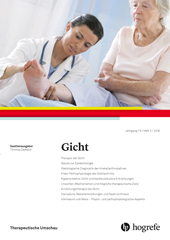Histo-Pathophysiologie der Gichtarthritis
Abstract
Zusammenfassung. Gicht ist eine häufige Ursache von entzündlichen Arthritiden und deformierenden Knochenerosionen. Die zugrundeliegende zelluläre und subzelluläre Entzündungsreaktion ist leider nur teilweise verstanden. Das Inflammasom als intrazellulärer Sensor von Uratkristallen führt zur Freisetzung von Interleukin (IL)-1. Histologisch führt die Anreicherung von Uratkristallen in der Synovialmembran zu deren Hyperplasie und zu einer Fibrinablagerung. In einem zweiten Schritt wandern neutrophile Leukozyten ein und es kommt zur Lymphozytenproliferation. Neutrophile Leukozyten induzieren NETs, welche wiederum entzündliche Zytokine degradieren können. Im Verlauf kommt es zudem zur vermehrten Expression von Tumor Nekrose Faktor (TNF)-Rezeptoren, welche als natürliche TNF-Hemmer wirken. Auch eine vermehrte IL-10 Expression ist beim Abklingen der Entzündung beteiligt. Bei der chronischen Gicht werden Tophi von Histiozyten und Riesenzellen umrandet. Herum bildet sich durch Fibrozyten eine fibrotische Reaktion mit vermehrter extrazellulärer Matrix. Auch hier kommt es zur Lymphozytenproliferation, wahrscheinlich einer Th-2 Polarisation welche die Fibrose weiter fördert. Lymphozyten sind durch die Bildung von RANK-Ligand auch an der Stimulierung von Osteoklasten und damit Knochenerosionen beteiligt. Zusammenfassend kann das Verständnis der Entzündungsreaktion bei der Gichtarthritis dabei helfen, neue therapeutische Ansätze zu entwickeln.
Abstract. Despite being a frequent cause of arthritis and bone erosions, the underlying cellular and subcellular reaction in gout is insufficiently understood. The inflammasome as intracellular sensor for crystals plays an important role, notably resulting in interleukin (IL)-1 production. Morphologically, hyperplasia of the synovial membrane with joint effusion, along with fibrinogen deposition and influx of neutrophils and lymphocytes are observed. Extracellular NET formation by neutrophils is involved in the regulation of inflammatory tissue reaction. Furthermore, the release of IL-10 and tumor necrosis factor (TNF)-receptors along with lymphocyte proliferation induce the natural resolution of acute gouty arthritis which typically occurs after several days. In contrast to acute gout, tophi consisting of urate crystals are surrounded by histiocytes and multinucleated cells, resembling a foreign body reaction. The deposition of extracellular matrix by fibrocytes is usually observed around tophi. This fibrotic reaction is likely enhanced by Th2-lymphocytes. Bone erosions in gout occur around tophi and are triggered by osteoclast activation through RANK-ligand expression by lymphocytes. In conclusion, understanding the orchestration of inflammation in gout might help to identify new therapeutic targets.



